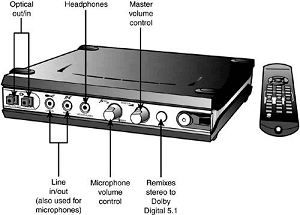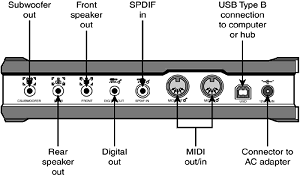Sound Cards Advanced Features
Many of the newest sound cards are designed for advanced gaming, DVD audio playback, and sound production uses and have additional connectors to support these uses, such as the following:
-
MIDI in and MIDI out. Some advanced sound cards don't require you to convert the game port (joystick port) to MIDI interfacing by offering these ports on a separate external connector. This permits you to use a joystick and have an external MIDI device connected at the same time. Typical location: external device.
-
SPDIF (also called SP/DIF) in and SPDIF out. The Sony/Philips Digital Interface receives digital audio signals directly from compatible devices without converting them to analog format first. Typical location: external device. (SPDIF interfaces are also referred to by some vendors as "Dolby Digital" interfaces.)
-
CD SPDIF. Connects compatible CD-ROM drives with SPDIF interfacing to the digital input of the sound card. Typical location: side of audio card.
-
TAD in. Connects internal modems with Telephone Answering Device support to the sound card for sound processing of voice messages. Typical location: side of audio card.
-
Digital DIN out. This supports multispeaker digital speaker systems, such as those produced by Cambridge for use with the SoundBlaster Live! series. Typical location: external device.
-
Aux in. Provides input for other sound sources, such as a TV tuner card. Typical location: side of audio card.
-
I2S in. This enables the sound card to accept digital audio input from an external source, such as two-channel decoded AC-3 from DVD decoders and MPEG-2 Zoom Video. Typical location: side of audio card.
-
USB port. This enables the sound card to connect to USB speakers, game controllers, and other types of USB devices. The Hercules Game Theater XP series, the first sound card with built-in USB ports, supports USB 1.1 only. Typical location: external breakout box.
-
IEEE-1394. This enables the sound card to connect to IEEE-1394-compatible DV camcorders, scanners, hard drives, and other devices. The Creative Labs Sound Blaster Audigy, Audigy 2, and Hercules Digifire 7.1 all feature one or more IEEE-1394 ports. Typical location: card bracket or external cable or breakout box.
Sometimes, these additional connectors are found on the card itself, or sometimes they are attached to an internal or external breakout box, daughtercard, or external rack. For example, the Sound Blaster Audigy Platinum 2 EX, Audigy 2 Platinum, and Hercules Game Theater XP 6.1 and 7.1 are two-piece units.
The Audigy audio adapter itself plugs into a PCI slot, but some additional connectors are routed to an internal breakout box on the Platinum, which fits into an unused 5 1/4'' drive bay. The top-of-the-line Platinum EX uses an external breakout box with the same connection options.
Both models feature a remote control (not shown) and external volume controls. The Hercules Game Theater XP series also features an external breakout box, which Hercules refers to as an audio rack. Figure below shows Voyetra Turtle Beach's Santa Cruz audio adapter card with the internal connectors common on today's 3D sound cards.

Traditionally, audio card upgrades have been designed specifically for users of desktop computers, leaving the growing number of notebook computer users out in the cold if they decided that the bare-bones features of their integrated audio weren't sufficient. However, the Creative Labs Sound Blaster Extigy allows both notebook and desktop computer users to add advanced I/O features without opening the system.
The front and rear panels of the Sound Blaster Extigy are shown in Figures 2 and 3, respectively. The Extigy connects to any system that has a USB 1.x or 2.x port, enabling the Extigy to be used on virtually any recent PC with any manufacturer's sound chip, sound card, or audio integrated chipset.

